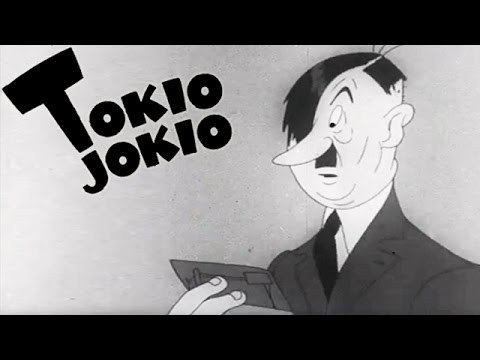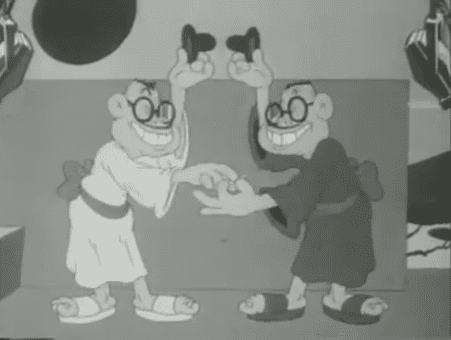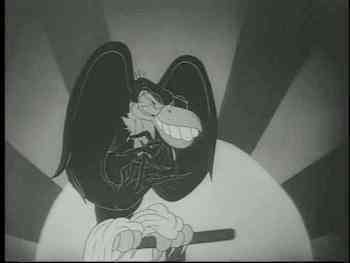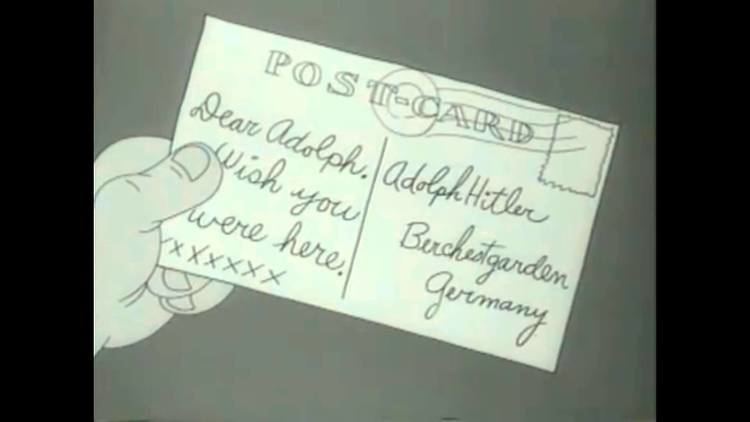Tokio Jokio
5.2 /10 1 Votes
Language English | 5/10 IMDb Genre Animation, Short, Comedy Duration | |||||||||||||||||||||||||||||||||
 | ||||||||||||||||||||||||||||||||||
Release date May 15, 1943 | ||||||||||||||||||||||||||||||||||
Banned cartoons japs bugs bunny tokio jokio 1943 b w
Tokio Jokio is a 1943 Looney Tunes short directed by Norman McCabe (Cpl. was added after the film finished production, as McCabe was drafted into the Armed Forces before its release). It is a propaganda film made during World War II mocking Japan in the style of a supposed Japanese film journal broadcast. Mel Blanc supplied all the voices. As with most of the Looney Tunes shorts produced during World War II, the film consists of a series of rapid-fire, short gag vignettes.
Contents
- Banned cartoons japs bugs bunny tokio jokio 1943 b w
- 1943 tokio jokio looney tunes hd hq
- Plot
- Controversy over stereotypes
- References

1943 tokio jokio looney tunes hd hq
Plot

The cartoon begins with a voiceover saying that a film captured from the Japanese, a typical example of vicious "Japanazi" propaganda, is now about to be released publicly. The film begins with a rooster who is about to crow. When he does, however, he changes into a vulture with glasses and buck teeth, while rubbing his hands. Behind him, the rising sun of the Japanese Rising Sun Flag appears. The voiceover says: "Ohh, cock-a-doodle-doo, Prease!", in a further emphasis that this vulture is Japanese.

The first segment is "Civilian Defense". The voiceover proudly presents the Japanese air raid siren system, which turns out to be two Japanese wearing kimonos taking turns in pricking each other in the buttocks with a needle. Then a listening post is shown, which is literally a pole with key holes in it, and an aircraft spotter, which is literally someone painting spots on a plane. The camera then moves to the fire prevention headquarters which has burned down to the ground.

Then a lesson about incendiary bombs is given. The text states that one should never approach incendiary bombs for the first five seconds. A small Japanese man with an umbrella appears, reads the text, checks his watch (which is decorated with Nazi swastikas) to count the seconds and then roasts a sausage above the dynamite stick. Then he explodes; emerging from the blast, he is headless, but his glasses and hat are still in the same place. The figure then says "Oh, rosing face, prease! Rosing face!" as a pun on the Asian concept of "losing face" or shaming oneself in public.
The second segment is "Kitchen Hints", which stars General Hideki Tojo as a cook. Tojo explains how a delicious Japanese club sandwich is made: a bread ration card is sliced in two, a piece of a meat ration card is put in between, then it is eaten and afterwards Tojo hits himself over the head with a club.
The third segment is a style show which shows the new Japanese victory suit: no cuffs, no pleats, no lapel and ... no suit! A small Japanese is shown at this conclusion, shivering in a cloth diaper in the snow, while trying to warm himself to a candle.
Then Red Toga-San brings us the highlights of today's Japanese sports, while talking out of an iris. Suddenly the iris fades out and his false teeth get stuck in the circle, before clattering to the ground. The Japanese "king of swat", his head shaped exactly like his trophy, is shown in his baseball outfit. Suddenly he spots a fly, which he tries to kill with a fly swatter, but misses and spins around in a circle. The fly grabs the swatter and clobbers him down. Afterwards it takes his trophy and flies away.
The fifth segment shows "Headline Poisonalities" (combination of "poison" and "personalities") who made headlines that week. A skull is seen in the title which changes into the face of Admiral Isoroku Yamamoto sitting at his desk. He introduces himself and then leaves his desk, while walking on stilts to look bigger. He tells the audience that he "will dictate peace term in the White House". An editor's note covers the screen which is written: "Editor's Note: this is the room reserved for Admiral Yamamoto". When the card is removed an electric chair room with an active electric chair is shown and Chopin's funeral march is quoted. (By the time the film was released, Yamamoto had been killed when the plane carrying him was shot down over the Solomon Islands by an American fighter squadron.)
The sixth segment is shown featuring General Masaharu Homma demonstrating, according to the voice-over, "coolness and calmness of Japanese Officer during air raid". Homma, however, does exactly the opposite and runs around in panic before ducking into a hallowed tree log. When he sticks his head out of the log, a skunk does the same. Disgusted by the smell of the Japanese, he ducks and reappears with a gas mask on his head.
"Flashes from the Axis" is the next (seventh) segment. Berlin, Germany: a monocled anthropomorphic donkey identified by a sign on his desk reading "Lord Hee Haw - Chief Wind Bag" (a caricature of the American-British radio broadcaster and Nazi collaborator William Joyce, nicknamed "Lord Haw Haw", or possibly of Fred W. Kaltenbach, who was himself nicknamed Lord Hee-Haw) brays loudly before announcing into a microphone that "the Führer had just received a postcard from a friend vacationing abroad". A hand holding the postcard is shown holding the postcard which reads: "Wish you were here" and then turns the card around to see the picture. It depicts Rudolph Hess in a prison camp (Hess had flown to Great Britain in 1941 and landed there by parachute to negotiate with the Allied Forces; he was arrested immediately). Adolf Hitler looks up in amazement and wiggles his nose. Rome, Italy: shots shown of the "celebrated" ruins of Ancient Rome and then cuts to Benito Mussolini sitting on a modern Roman ruin whilst yo-yoing a yo-yo, titled "Ruin #1".
The next (eighth) segment focuses on the Japanese navy achievements. A large submarine is shown "three weeks ahead of schedule", according to the voice-over. Indeed, they are still working on it while it moves under water. After this, a group of Japanese submarine sailors are shown using "intricate and technical machinery", which are actually pinball machines, slot machines and a peep show machine.
The ninth segment a Japanese sailor is shown piloting a Kaiten human torpedo on a dangerous mission. The voice-over tells us that the pilot does not care about the danger, but when he asks him if he has anything to say the pilot exclaims: "No, nothing, except...RET (LET) ME OUT OF HERE!", apparently stuck in the torpedo.
The tenth (and final) segment includes scenes that are again literal interpretations of certain marine boats and air force planes. A plane is shot into the air with a large catapult, another plane is shown with a tricycle landing gear (actually a small man riding a tricycle attached to the plane), an aircraft carrier is presented (which carries remains of crashed planes) and a mine sweeper (a boat with two mechanical hands operating a broom to sweep mines away). When this ship accidentally explodes, a buoy is dropped in the sea with the note: "Regrettable incident please". Then the cartoon irises out.
Controversy over stereotypes
The cartoon was intended as an American propaganda film against Japan while the two countries were at war. The depiction of the Japanese would generally be considered racist by today's standards. All the Japanese are shown wearing big glasses, having buck teeth and grinning and rubbing their hands in a very sinister way. Their stereotypical politeness is mocked by their continuous use of the words: "please", "regrettable" and "honorable". Also, their language is spoofed by adding many "Ooo's" at the start of every sentence and replacing the letter "l" with the letter "r" and vice versa.
Furthermore, the Japanese are represented as being incompetent, weak, cowardly, and primitive. Some were completely false: Japanese were more than competent baseball players, allowing for the eventual rise of Nippon Professional Baseball and the creation of a posting system several decades later that allowed Major League Baseball teams to buy the rights to Japanese players from their home clubs. Although the jokes are generally aimed at Japan, the cartoon also pokes fun at Lord Haw Haw, Rudolph Hess, Adolf Hitler and Benito Mussolini.
As with a lot of World War II cartoons in America, this hasn't aired on any network, syndicated, or cable channel due to its offensive content. However, the Cartoon Network animation history show ToonHeads once showed clips of this cartoon during a special episode about World War II-era cartoons, with a voiceover explaining that the cartoon, like many others at the time, had very cruel depictions of the Japanese.
References
Tokio Jokio WikipediaTokio Jokio IMDb Tokio Jokio themoviedb.org
